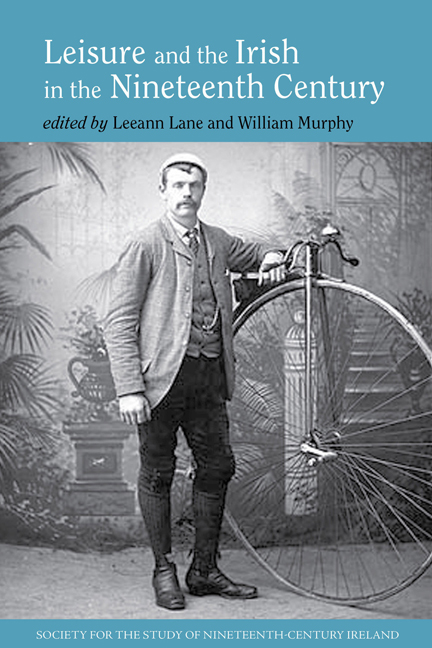Book contents
- Frontmatter
- Contents
- List of Figures and Tables
- Introduction
- Leisure and Associational Culture
- Leisure Spaces
- Leisure in Literature
- Leisure, Tourism and Travel
- 9 From Drogheda to Jerusalem, and a Riot: The Travels of Thomas Brodigan of Piltown, 1845–1846
- 10 ‘Bad roads will absolutely nip in the bud the new development’: Cycling Tourism in Ireland in the Late Nineteenth and Early Twentieth Centuries
- Leisure and Female Élites
- Notes on Contributors
- Index
10 - ‘Bad roads will absolutely nip in the bud the new development’: Cycling Tourism in Ireland in the Late Nineteenth and Early Twentieth Centuries
from Leisure, Tourism and Travel
- Frontmatter
- Contents
- List of Figures and Tables
- Introduction
- Leisure and Associational Culture
- Leisure Spaces
- Leisure in Literature
- Leisure, Tourism and Travel
- 9 From Drogheda to Jerusalem, and a Riot: The Travels of Thomas Brodigan of Piltown, 1845–1846
- 10 ‘Bad roads will absolutely nip in the bud the new development’: Cycling Tourism in Ireland in the Late Nineteenth and Early Twentieth Centuries
- Leisure and Female Élites
- Notes on Contributors
- Index
Summary
Cycling witnessed a remarkable growth in popularity in Ireland in the late nineteenth and early twentieth centuries. At first, in the 1860s, the pastime was participated in by a tiny number of individuals, who rode crude and unwieldy velocipede bicycles that were propelled by the riders pushing pedals on the front wheels. The fact that such bicycles were nicknamed ‘boneshakers’ provides a good insight into how uncomfortable an experience it was to ride these machines. The introduction of the high-wheeled ‘ordinary’ or ‘penny-farthing’ bicycle in the early 1870s quickly rendered the velocipede obsolete and led to an increase in cycling's popularity, especially amongst young middle-class men; the introduction of the tricycle later in the decade meant that many less adventurous men, as well as some women, could also take up the new pastime. The invention of the chain-driven safety bicycle in the mid-1880s, along with the introduction of the pneumatic tyre in 1889, sparked off a dramatic cycling revolution in the 1890s: by the latter decade's end, although cycling still remained a mainly middle-class activity, it was a genuinely popular phenomenon, rather than the niche pastime that it had been in the 1860s. One of the significant ways in which cyclists enjoyed their hobby was by undertaking cycling tours in the Irish countryside.
The topic of tourism in the nineteenth and early twentieth centuries is one that has attracted the attention of a number of historians of leisure in Ireland in recent years. Ireland attracted tourist visitors throughout the eighteenth century and in the decades before the Great Famine, many of whom published accounts of their impressions of the country. Ireland became an even more popular tourist destination in the post-famine decades, particularly as the expansion of the railway in this period meant that tourists could penetrate further into the country, and at greater ease, than had been the case before the famine. The railway companies, aware of the potential profits to be made from developing tourism, made considerable efforts to cater for tourists’ comfort – and to attract their custom – by building hotels at popular tourist destinations such as Killarney, Kenmare, Galway, Clifden, Bundoran and Rostrevor, to name just a few.
- Type
- Chapter
- Information
- Leisure and the Irish in the Nineteenth Century , pp. 187 - 206Publisher: Liverpool University PressPrint publication year: 2016



